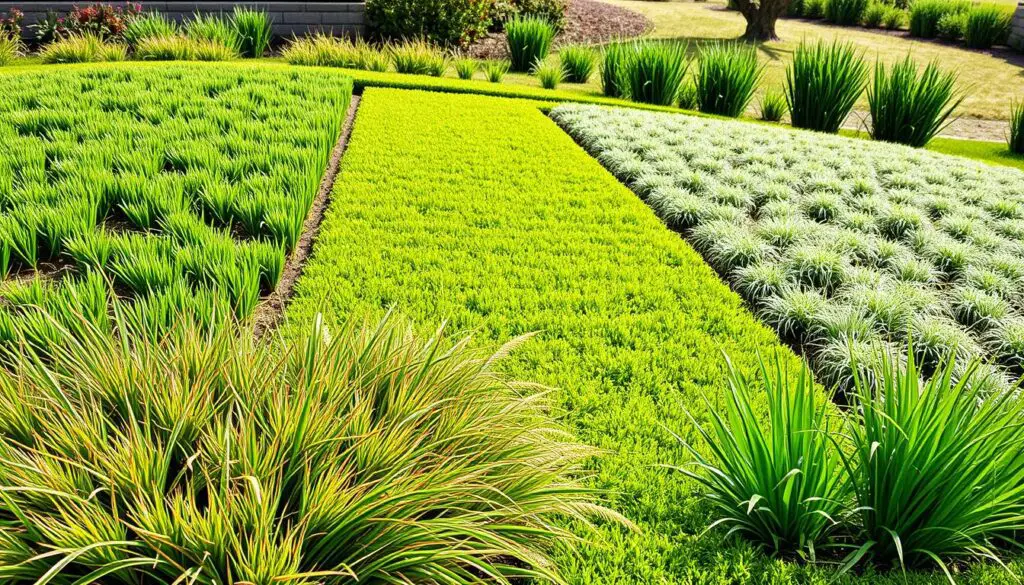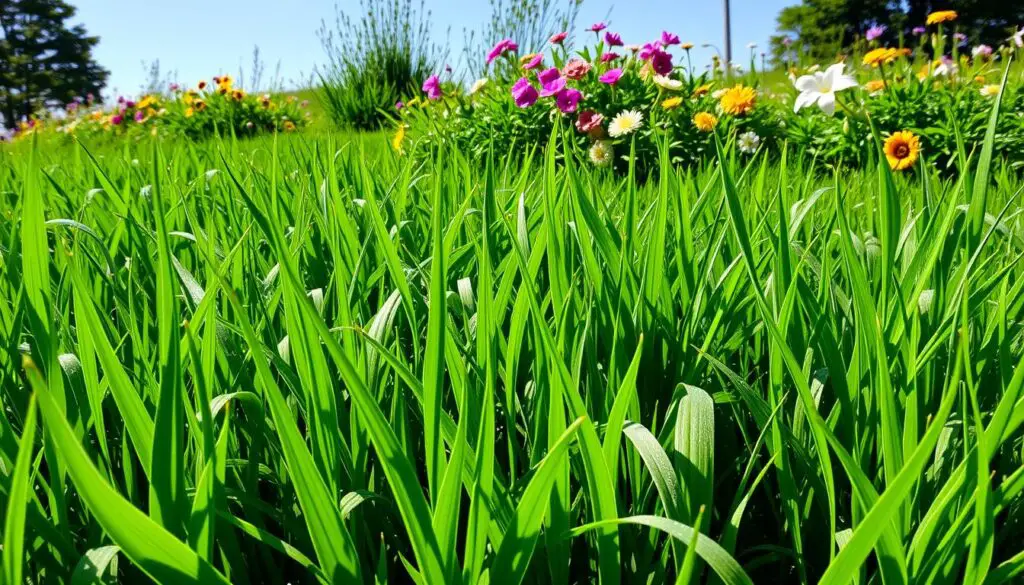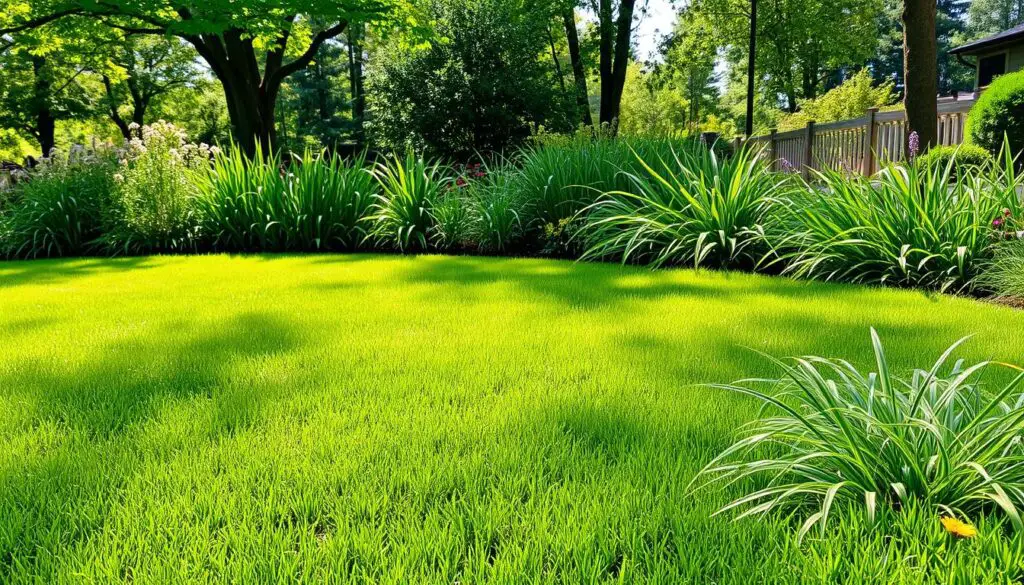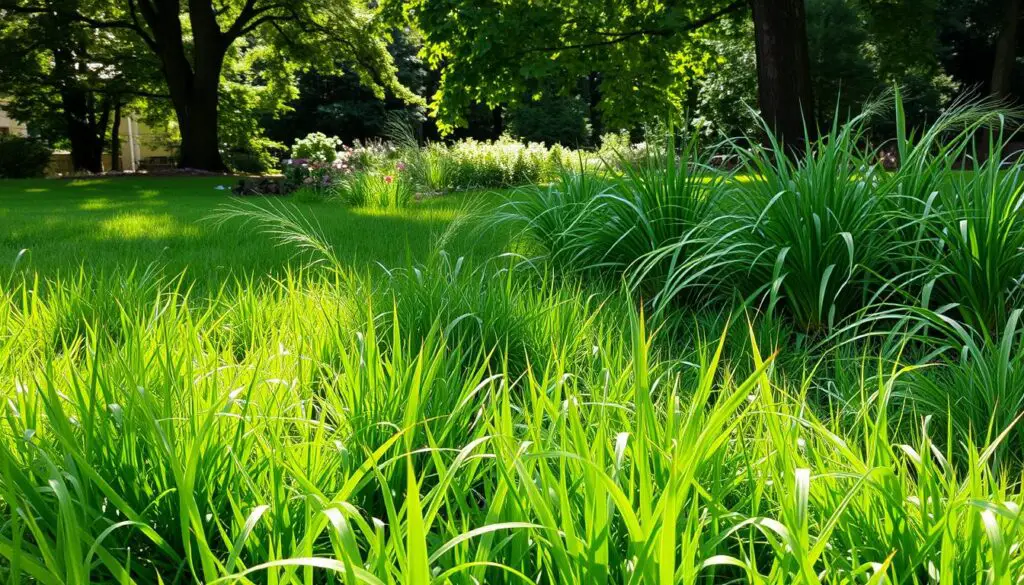What Type of Grass Is Best for Your Lawn?

Did you know that 10% of the total vegetation in the western United States is Kentucky Bluegrass? This shows how important picking the right grass for our lawns is. The grass we choose can greatly affect our lawn’s health and look. In this article, I’ll show you the top ten grass types for a beautiful lawn and how to pick the best one for you.
Our lawn grass is key to a healthy environment. It keeps the soil and air clean, prevents erosion, and controls temperature. To care for our plants well, we need to know about each turf grass variety for lawns, their special features, and how to keep them up. Whether you want low maintenance lawns, drought-tolerant grasses, shade-tolerant grasses, or high-traffic grass types, this guide will help you choose wisely.
We’ll look at warm season grasses like Bermuda Grass and cool season grasses like Kentucky Bluegrass. We’ll also cover ornamental grasses and grass seed blends. So, let’s start exploring the best grass types for your needs!
Key Takeaways
- Lawn grass is vital for a healthy, beautiful outdoor space.
- There are many turf grass varieties, from warm season grasses to cool season grasses.
- Consider maintenance requirements, drought tolerance, shade tolerance, and traffic levels when choosing grass.
- Grass seed blends offer a mix of grass types for a healthy lawn.
- Proper soil prep and planting are crucial for a thriving lawn.
Understanding Different Grass Types
Cool-Season Grasses vs. Warm-Season Grasses
Knowing the difference between cool-season and warm-season grasses is key for a healthy lawn. Cool-season grasses like Kentucky Bluegrass, Tall Fescue, Ryegrass, Fine Fescue, and others grow best in spring and fall. They do well from April to early July or late winter to early spring, depending on where you live. These grasses create a dense, lush lawn but struggle with heat and drought, needing more water in summer.
Warm-season grasses, including Bermudagrass, St. Augustine/Floratam, Zoysiagrass, and Centipedegrass, grow best in the warmest months, from June to early September. They have deep roots, making them very heat and drought tolerant. But, they may turn brown in winter and don’t do well in shade as much as cool-season grasses.
Choosing between cool-season and warm-season grasses depends on your climate and what you like. Warm-season grasses are great for the Southern United States. Cool-season grasses do well in areas with big temperature changes, like the North, Northeast, and Pacific Northwest.
“About a dozen different grass types exist, with most lawns containing a mixture of them.”
It’s important to know the special traits of each grass type. This includes their growing season, root systems, shade tolerance, and drought resistance. This knowledge helps pick the best grass for your lawn and climate.
Selecting the Right Grass for Your Region
Choosing the right grass for your lawn is key. It must match your local climate and growing conditions. Different parts of the United States need different types of grass. This includes regional grass types, climate-appropriate grass, lawn grass selection, grass growing conditions, and grass maintenance requirements.
In coastal areas of the Pacific Northwest, grasses that fight off fungal diseases are needed. These areas have cool, wet weather. Pennington Smart Seed Perennial Ryegrass and Pacific Northwest Grass Seed blends are good choices.
On the West Coast, Kentucky Bluegrass and Tall Fescue are popular. They do well in different conditions. Pennington’s The Rebels Tall Fescue Grass Seed Blend and Smart Seed Bermudagrass Grass Seed are great options.
In the Upper Midwest, Perennial Ryegrass and Tall Fescue are recommended. They are durable and can handle drought. Pennington Smart Seed Perennial Ryegrass Grass Seed and Fertilizer Mix are good choices.
The Northeast prefers cool-season grasses like Kentucky Bluegrass. Pennington’s Kentucky Bluegrass Grass Seed and Fertilizer Mix are a good fit.
The Transition Zone and the Deep South have their own challenges. In the Transition Zone, Tall Fescue and Kentucky Bluegrass are common. But in the Deep South, warm-season grasses like Bermudagrass, Zoysiagrass, and St. Augustinegrass are more common.
Choosing the right lawn grass is crucial for a lush, low-maintenance lawn. Knowing the specific needs of different grass types helps you make the best choice. This ensures your lawn will thrive with minimal care.

“Selecting the right climate-appropriate grass is essential for establishing a healthy, low-maintenance lawn that thrives in your local environment.” – Lawn Care Specialist
Top Warm-Season Grass Options
In the southern half of the United States, warm-season grasses are top picks for a lush lawn. Bermudagrass and St. Augustinegrass are the most popular choices.
Bermudagrass
Bermudagrass is known for its excellent traffic, heat, and drought tolerance. It grows fast and offers a dense, light green cover. But, it needs frequent mowing and can build up thatch. It’s best seeded or planted with sprigs/plugs and needs full sun.
St. Augustinegrass
St. Augustinegrass is the most shade-tolerant warm-season option. It grows quickly and handles heat and drought well. But, it’s not good with traffic and needs regular care. It’s best grown from sprigs/plugs and also needs full sun.
| Grass Type | Heat Tolerance | Drought Tolerance | Maintenance Requirements |
|---|---|---|---|
| Bermudagrass | Excellent | Excellent | Frequent Mowing, Prone to Thatch |
| St. Augustinegrass | High | High | Regular Maintenance, Low Traffic Tolerance |
Choosing the right warm-season grass depends on your region’s climate, soil, and lawn needs. This ensures your grass grows well and is easy to care for.
“Warm-season grasses are best for lawns in the southern half of the United States, characterized by active growth during warm seasons.”
Best Cool-Season Grasses
Cool-season grasses are a favorite for lush lawns in northern U.S. homes. Kentucky Bluegrass stands out for its dense, durable turf. It’s great for areas with lots of foot traffic.
Kentucky Bluegrass loves cooler weather and does well in the cool season. But, it needs more water in hot, sunny days to stay green.
This grass spreads quickly, filling in bare spots and making lawns look even. Its deep root system helps control erosion. It’s perfect for places with lots of people, like sports fields and golf courses.
Maintaining Kentucky Bluegrass takes some work, but it’s worth it. With the right care, it grows into a stunning, dense, and durable lawn. It will make your neighbors jealous.

“Kentucky Bluegrass is a true champion of the cool-season grasses, delivering a lush, inviting lawn that can withstand heavy foot traffic and enhance the overall curb appeal of any property.”
best grass types for High-Traffic Areas
Choosing the right grass is key for a healthy lawn in busy areas. Some grasses handle heavy use better than others. This keeps your outdoor spaces welcoming and strong. Let’s look at the best grasses for areas with lots of foot traffic.
Bermudagrass is a top pick for warm weather. It’s tough and can handle lots of steps. But, it doesn’t do well in cold weather. On the other hand, Kentucky bluegrass is good for cooler places. It can handle some foot traffic and dries out slowly.
Perennial ryegrass is another cool-season grass. It’s good for both cold and warm places. But, it might not bounce back quickly after lots of steps. Tall fescue is also cool-season. It’s strong and works well in different temperatures and water levels.
In warm weather, seashore paspalum is a great choice. It’s strong and needs some care. Zoysiagrass is also warm-season. It’s cold-tolerant and perfect for hot, humid places in the South and California.
Keeping your lawn healthy is important, no matter the grass type. Regular mowing, watering, and fertilizing help. This keeps your grass strong and ready for lots of steps.
| Grass Type | Traffic Tolerance | Climate Suitability | Maintenance Needs |
|---|---|---|---|
| Bermudagrass | High | Warm Regions | Moderate |
| Kentucky Bluegrass | Moderate to High | Northern US | High |
| Perennial Ryegrass | High | Northern and Southern US | Moderate |
| Tall Fescue | Moderate to High | Adapts Well | Low |
| Seashore Paspalum | High | Warm Regions | High |
| Zoysiagrass | High | Southern US and California | Moderate |
Choosing the right grass types for high-traffic areas is key. This keeps your lawn looking great and strong. With the right care, these grasses will keep your outdoor space beautiful and inviting.
Low-Maintenance Grass Varieties
Keeping your lawn green can take a lot of time. But, there are grass types that need less care. Buffalograss, Centipede grass, and fine fescues are great for those who want to spend less time on lawn care. They grow slower, need less fertilizer, and don’t need to be mowed or watered as often.
Fine fescues, like Slender Creeping Red Fescue and others, are also good choices. Mixing different types of fine fescue helps them grow well together. They need to be mowed every 4-6 weeks, keeping them at 3″ to 4″ tall.
Turf Type Tall Fescue (TTTF) is another low-maintenance option. It can handle drought well and needs less water and fertilizer. It’s best for the northern to central parts of the transition zone. Mowing it every 7 days at 3″-4″ height is recommended.
Buffalograss is a warm-season grass that’s popular in the Great Plains and Southwest U.S. It needs little fertilizer and is mowed every 2 to 4 weeks. Centipede Grass is great for the Southeast U.S. and Gulf Coast of Texas. It grows slowly and can handle drought well.
Zoysia grass is good for the transition zone and southern regions. It’s easy to care for and spreads quickly. It needs about 4 hours of sunlight a day and grows well in USDA Growing Zones 7-10.

Choosing low-maintenance grasses means you can enjoy your lawn more. These grasses are beautiful and don’t require a lot of work. They’re perfect for those who want a lovely lawn without the hassle.
Shade-Tolerant Grasses
Keeping your lawn green can be tough, mainly in shaded spots. Luckily, there are shade-tolerant grass types that do well in these areas. Fine fescues and St. Augustinegrass are top picks.
Fine Fescues and St. Augustinegrass
Fine fescues have a fine texture and love the shade. They’re perfect for spots with little sunlight. St. Augustinegrass, on the other hand, does well in both sun and shade.
About 25 percent of lawns get some shade. St. Augustine grass can handle as little as four hours of direct sun. Other warm-season grasses need more. Cool-season grasses like Fescue and Ryegrass can do with less sunlight.
When picking a shade-tolerant grass, think about your area’s climate and sunlight. The right grass can make your lawn look great, even in the shadiest spots.

“Grasses like bahiagrass, carpetgrass, and bermudagrass are shade-tolerant and warm-season, while bentgrass and some Kentucky bluegrass cultivars are shade-tolerant and cool-season.”
Factors to Consider When Choosing Grass
Choosing the right grass for my lawn involves a few important steps. First, I’ll look at my local climate. Warm-season grasses do well in hot, dry areas. Cool-season grasses are better in cooler places.
The amount of sun my lawn gets is also key. Some grasses, like tall fescue, can handle shade. Others need full sun.
Next, I’ll think about how I’ll use the lawn. For busy areas, I’ll pick durable grasses like Bermudagrass or zoysiagrass. Shady spots might do better with fine fescues or St. Augustinegrass. For easy care, Canadian bluegrass or wheatgrass could be great.
In the end, I want grass that fits my environment and looks good. By considering these factors, I can pick the best grass for a beautiful lawn.

